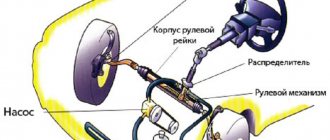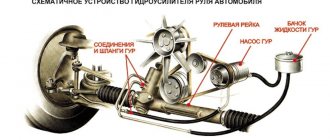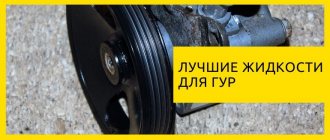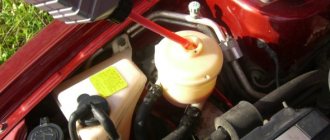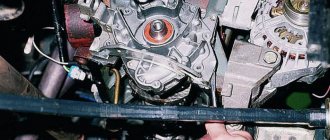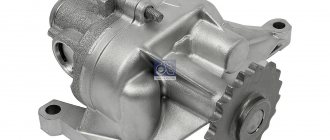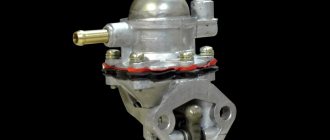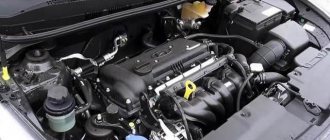Replacing the power steering pump bearing on a Hyundai Solaris
I want to share my experience in power steering repair.
I'll start from the beginning. There were always extraneous sounds under the hood (especially in the morning when starting the engine), one of the reasons was the power steering bearing. I was pretty fed up with this whole story and decided to correct the situation. PREPARATION
- I went to the nearest store and bought 3 NTN 6203 bearings
at a price of
350 rubles.
a piece.
3 pieces because I immediately changed the bearings in the drive belt rollers. - a power steering pump repair kit 57150-34A00
from E*i$t at a price of
242 rubles. - Power steering fluid HYUNDAI NEW PSF-3 SAE 80W 0310000110 brown
, costs 660 rubles in the store
.
for 1 liter (it was enough for me). - PYVO can not be considered
Result: 1252 rub. It cost me less because... There was still packaged oil from another car (KIA Sorento 2006).
DISASSEMBLY
- First of all, we pump out the liquid from the expansion tank as much as possible (a mesh is installed).
- We cover the entire space with rags and remove the hoses from the pipes.
- We pump out the liquid from the pipes and through the hose from the expansion tank so that it does not flow.
- Remove the expansion tank. Without it, it’s easier to reach the rollers and remove the belt, and it doesn’t hurt to wash it.
- We remove the tensioner and remove the belt. It was easier for me to do it from below with a spanner.
- We completely unscrew the pipeline bolt (24) and disconnect the pipeline. AT THIS MOMENT THE MAIN THING IS NOT TO LOSE THE 2 COPPER SPACERS (attached to this bolt).
- We unscrew the two bolts securing the pump body (short at the top, long at the bottom) and, with a slight movement, rocking the pump body, remove it from the mounting location.
PUMP IN HANDS.
REPAIR
- We clamp the pump body in a vice. We fix the pulley with any available object and unscrew it.
- We unscrew the 4 bolts from the back side and carefully remove the back part of the pump (it’s better not to turn it over - the pump petals will scatter.).
- We take out the insides of the pump (the rotor with petals and the black round piece of iron with cutouts).
- Remove the retaining ring (clip) in front of the bearing (from the pulley side), tapping on the rear end of the pump shaft to knock out the bearing.
- Carefully remove the bearing from the axle in a vice. It is advisable to use a puller, but in the absence of...
- We change the bearing and all the rubber bands with the gasket.
- Do not forget to thoroughly clean the internal cavity and components of the pump to prevent dust and dirt from entering there.
- We reassemble the pump in reverse order.
The heads from the kit are perfect for pressing in the oil seal and bearing.
INSTALLATION
- After assembling and installing the power steering, we connect one pipe and immerse the second in the prepared bottle (the free hose can be plugged with a bolt).
- We pour oil into the tank and slowly turn the steering wheel in different directions (DO NOT START THE CAR.).
- The oil gradually displaces the old slurry from the rack and the entire system.
- Add to the tank and pump until clean oil flows out (a liter was enough for me).
- We connect the last pipe, add oil to the tank and start the car.
- We turn the steering wheel several times to the extreme positions (remember to monitor the oil level in the tank).
- We set the level.
Power steering buzzes
Has your power steering started to hum? Then this article is just for you. Let's figure out what could cause the malfunction and lead to these consequences?
So, it’s quite a lot to cause extraneous sounds, in particular hum, power steering. First of all, you must understand that the problem lies in a faulty control system. And the more quickly you react and eliminate the problem, the more money you will save.
Below I will give the reasons for the occurrence of extraneous power steering sounds and examples of how to eliminate them.
Power steering device
Low fluid level in the power steering system.
We assess the amount of oil in the power steering system. To do this, we climb under the hood and look at the expansion tank with oil. The normal oil level is between MIN and MAX. When. If the oil is below the required level, then you need to identify and eliminate the cause of the leak (this could be the tank itself, cracked clamps, hose joints). Having eliminated the leak, add oil to the required level.
Correctly selected liquid.
Pay attention to what you put into your hydrocha system. The liquid poured into it must meet the manufacturer’s requirements, otherwise you can run into serious consequences, much more serious than just a hum.
Poor quality fluid or dirty fluid in the system.
Again, returning to point 2, pay attention to what you pour into the system. Select it correctly in all respects, and don’t cheapen it. After all, too cheap oil can lead to serious consequences. No one has canceled the effect of the saying “the miser pays twice.” The system can become clogged with too much heat; in addition to a hum, the steering wheel hardens and becomes extremely difficult to turn. In this case, just as in point 1, we dive under the hood and look at the expansion tank. The oil in it should not be dark, much less somehow thick (lumpy). If you find that the oil is far from normal, we immediately replace all the oil in the system. If it is difficult for you to diagnose the oil through the tank, then we arm ourselves with a syringe into which we draw a small amount of oil. Then we squeeze it onto a white, clean piece of paper and look. Ideally, the oil should be close to the color of the new oil, but there are acceptable exceptions (for example, slight reddish and its shades, as well as bluish, are possible). The most important thing is that you must clearly understand that the oil is not dark (not brown, not gray, not black).
Next we analyze the smell. To do this, we sniff the open tank. The smell should ideally not be somehow unpleasant or pungent. The smell of burnt rubber and rancid oil is not allowed.
Be sure to periodically change the fluid as recommended, i.e. every 60-110 thousand km.
Airing the system
In other words, air is walking (entering) the system. This is an extremely unpleasant situation, because... leads to damage to the power steering pump. To identify this phenomenon, we check for the presence of foam inside the oil tank. If foam is detected, then replace the fluid in the power steering system and pump it completely.
Failure of the steering rack.
To eliminate the possibility of this problem. First you just need to visually assess the condition of the steering rack. In addition to the power steering hum, signals of a problem with the rack are: the appearance of a knocking sound in the body or in the area of the front wheels.
This, in turn, is preceded by wear of the gaskets and steering rod boots, which entails leakage of working fluid, clogging of the rack with dust and dirt, and as a result, the appearance of a knocking sound.
We purchase a new repair kit and replace it. If you can’t handle it on your own, then take the car to a specialist.
I beg you and really insist that driving with a faulty steering rack is fraught with dire consequences! Don't joke or play with this matter.
Weak power steering belt tension.
It is very easy to identify this problem. Let's start the engine. Let the car rattle for a while, then turn it off. We touch the belt with our hand. A hot belt indicates that it is slipping along the pulley, which causes the belt to heat up. The tension itself is determined using the manual. If you don’t have it, then STOshka can help you. If the belt is already worn out enough, we replace it.
Damage to the power steering pump.
Unfortunately, I have to admit that this type of breakdown of the Sami is unpleasant due to its high cost. A sign that you have encountered this particular problem is that the steering wheel is jammed (i.e. maneuvering the steering wheel is very difficult). The pump can be damaged by: bearings, impeller, seals.
Dirty power steering fluid
When the "hydrach" hums when it's cold
The main reasons why power steering can be capricious when cold are:
| Cause | Elimination method |
| 1. Air is through the low pressure lines | 1) Install a pair of clamps on the tube leading from the reservoir to the power steering pump. 2) We replace the sealing ring located on the suction pipe of the pump itself. 3) Upon completion, coat the whole thing with sealant (oil-resistant) |
| 2. Poor pumping of the power steering system | 1) There is an air bubble in the tank, which is removed using a syringe. 2) replacement of oil hoses and/or rack, 3) replacing the power steering pump, 4) installation of additional clamps on all hoses in order to prevent air leaks into the system |
| 3. No dirt in the system fluid | Getting rid of dirt in the tank Checking the condition of the filter in the tank (if there is one); if it is clogged, either clean it or change it Replacing the expansion tank if required Removing and disassembling the rack, as well as cleaning it from dirt. Replacement of all rubber-plastic parts (they are included in the new repair kits) |
| 4. External bearing of power steering pump. | Just replace it |
| 5. High viscosity oil | Change the oil to one that meets the requirements of the region in which the car is operated |
Rumble on "hot"
The main reasons why power steering can act up when hot are:
| Cause | Elimination method |
| Vibration in the steering wheel | Remove the old pump and install a new one. If the old one is subject to minor repairs, then repair it and return it back |
| The power steering knocks only at low speeds, at high speeds it is completely absent | This problem indicates that the pump is failing. If you encounter this problem, there are two options for solving the situation: completely change the pump, or try pouring thicker oil into the system. |
| Lack of required pressure in the system | In this case, you need to replace the oil with a higher quality one (if you know that you poured something budget) |
| Failure of the steering rack | Replace the seals, because their wear leads to leakage of liquid, and as a result it becomes more liquid. |
Power steering pump bearing
The sound of the power steering hum appears in extreme positions
The humming sound can cause a car to remain with the wheels turned for too long. Turned wheels place a heavy load on the power steering pump and it begins to make strange sounds.
If you realize that the car makes such sounds not because the wheels are turned, but for some other reasons, then be sure to carry out diagnostics according to the above points:
- Pump operation
- Liquid level in the expansion tank
- Power steering drive belt tension force
- Liquid purity
Another reason for the hum in extreme positions may be the blockage of the hydraulic flow. In this case, the pump operates on itself, and the system does not cool.
Do not turn the front wheels for long periods of time
After the replacement, the power steering hums
Main reasons:
- Low quality oil or oil of inappropriate thickness. To avoid such a problem, follow the manufacturer's recommendations for choosing power steering oil.
- Airing the power steering system. Read above to find out how to get rid of this problem.
Basic nuances for operating the hydraulic booster system:
- Maintaining the oil level in the system. Periodic diagnostics (for color, smell).
- The delay of the wheels in extreme positions should not exceed 5 seconds. Remember that this puts a lot of stress on the cooling system and pump.
- The car remains in the parking lot only with straight wheels. This step allows you to unload the power steering system when starting after parking. It is especially important to remember this in cold weather (oil quickly cools and thickens).
- Immediate diagnosis and repair in case of extraneous sounds.
- Maintaining the steering rack in good condition. Periodic inspection and diagnosis.
Summarize
If your car begins to make uncharacteristic sounds (humming, knocking, vibration, etc.), do not delay inspecting it and identifying the problem. It is very important. The main thing in dealing with power steering is not to miss the moment when you lose control of the car. Don’t skimp on consumables, don’t add the lousiest oil. Good luck!
If these reasons are not identified, then check the car for all
Replacing the power steering pump bearing on a Hyundai Solaris
We replace the hydraulic power steering pump if it fails
To replace the pump you need keys: 12, 14, 19, 24, a flat-blade screwdriver, a syringe and a mounting spatula
Remove the auxiliary drive belt
Loosen the supply hose clamp by squeezing the bent ends of the clamp with pliers
Slide the clamp along the hose
Disconnect the supply hose from the pump nozzle
Drain the fluid from the power steering reservoir into a prepared container
Squeeze the clamp of the power steering fluid pressure sensor wiring harness
Remove the wiring harness holder from the bracket on the power steering pump housing
Unscrew the bolt fitting of the pressure pipeline
Remove the bolt along with the sealing washer
Disconnect the pressure pipe with the sealing washer installed underneath it from the pump
In this case, a small amount of liquid may leak out of the pump pipeline.
Remove the sealing washer
We plug the pipeline in any way so that the working fluid does not leak out of it
Using a syringe, drain the remaining working fluid from the power steering pump
We unscrew the two bolts securing the pump to the engine bracket (the second bolt is located under the pump pulley)
Remove the pump from the engine bracket
We release the clamp of the wiring harness block
Disconnect the block from the power steering fluid pressure sensor
We unscrew the two bolts securing the power steering supply circuit pipeline
Use a screwdriver to pry off the O-ring
Remove the ring from the power steering pump
Unscrew the power steering fluid pressure sensor
To prevent dirt from entering the pump, plug the holes in the pipeline and sensor
Unscrew the pressure pipeline valve
Unscrew the pulley fastening nut
Removing the power steering pump pulley
Install the hydraulic pump in reverse order
We put on the auxiliary drive belt
Pour working fluid into the system and pump it
How to repair a power steering pump with your own hands
Before you start disassembling the device, you need to check whether there is an air lock in the system that is interfering with the movement of fluid. It is because of the airlock that problems most often occur in hydraulic systems. That is, first of all we pump the power steering. If after this the reasons do not disappear, then we proceed to dismantling the hydraulic unit, disassembling it and repairing system parts.
Repair sequence:
- We do a complete cleaning of dirt. At the same time, make sure that dirt does not get into the hoses.
- Remove the drive belt.
- Drain the oil as much as possible.
- Now you need to put a mark on the power steering shaft relative to the elastic coupling (to do this you will have to crawl under the car). Using a hexagon, unscrew the steering shaft.
- We dismantle the steering rods. To do this, you need to lift the left side of the car with a jack and remove the wheel. Usually, to remove the rods, you need to use a special puller. But, in this case, this can be done without a puller.
- Take a 15mm socket wrench and loosen the bolts securing the power steering to the side member. This is done from the side of the wing arch. We unscrew 2 bolts completely, leaving one in place.
- Now, what remains in the hoses needs to be drained. To do this, substitute a cut empty canister or other container.
- When the liquid has flowed out of the hose, you need to plug them with rags.
- Now you need to unscrew the remaining one bolt. We unscrew it with one hand and hold the hydracha device with the other.
- Carefully and slowly remove the pump.
Once the pump is removed, we begin to disassemble it.
First, we inspect whether the body is broken or whether there is metal corrosion. During disassembly, the cause of the breakdown is usually found out. Next, we disassemble the pump into its components.
How to disassemble the power steering pump:
- The retaining ring holds the bearing. This ring must be removed using a puller.
- Unscrew the bolts securing the rear cover. Remove the cover using a slotted screwdriver. You must remove it carefully so that the blades and the pump housing do not fly out.
- Those who do not remember the location the first time are advised to take blank A4 sheets, number them and lay them out. During the disassembly process, the parts are laid out on these sheets in a certain order. You also need to remember that the rounded part of the blades must then be installed outward.
- Now you need to remove the plate and the parts underneath it.
- After this, we proceed to removing the shaft. It must be carefully knocked out; for this you can use a brass hammer or a rubber one, which is used by tilers.
- The bearing must be pressed out from the removed shaft.
- If the problem was in the bearings, that is, it may be jammed, or crumbled, or simply rotates tightly, then we press in a new bearing.
- In addition to the bearing, it is necessary to check all parts of the device and, if necessary, replace them.
- At this stage, when the failed parts have been replaced, it is necessary to assemble the power steering device.
Replacing the power steering pump bearing on a Hyundai Solaris
I want to share my experience in power steering repair. I'll start from the beginning. There were always extraneous sounds under the hood (especially in the morning when starting the engine), one of the reasons was the power steering bearing. I was pretty fed up with this whole story and decided to correct the situation.
PREPARATION
- I went to the nearest store and bought 3 NTN 6203 bearings
at a price of
350 rubles.
a piece.
3 pieces because I immediately changed the bearings in the drive belt rollers. - a power steering pump repair kit 57150-34A00
from E*i$t at a price of
242 rubles. - Power steering fluid HYUNDAI NEW PSF-3 SAE 80W 0310000110 brown
, costs 660 rubles in the store
.
for 1 liter (it was enough for me). - PYVO can not be considered
Result: 1252 rub. It cost me less because... There was still packaged oil from another car (KIA Sorento 2006).
DISASSEMBLY
- First of all, we pump out the liquid from the expansion tank as much as possible (a mesh is installed).
- We cover the entire space with rags and remove the hoses from the pipes.
- We pump out the liquid from the pipes and through the hose from the expansion tank so that it does not flow.
- Remove the expansion tank. Without it, it’s easier to reach the rollers and remove the belt, and it doesn’t hurt to wash it.
- We remove the tensioner and remove the belt. It was easier for me to do it from below with a spanner.
- We completely unscrew the pipeline bolt (24) and disconnect the pipeline. AT THIS MOMENT THE MAIN THING IS NOT TO LOSE THE 2 COPPER SPACERS (attached to this bolt).
- We unscrew the two bolts securing the pump body (short at the top, long at the bottom) and, with a slight movement, rocking the pump body, remove it from the mounting location.
Gur in Solaris, what is it? Hydraulic power steering.
Actually, it is needed to make it easier to turn the steering wheel. But there are also many other useful properties. Thanks to the Solaris hydraulic booster, from
The steering wheel doesn't get hit by uneven road surfaces, and even if a tire blows out, you still won't lose control.
Maneuverability will be much higher than that of a car without steering wheel, control is easier, almost all the power work is done for you by the Solaris hydraulic booster, therefore, it will take you much less time to make a turn or turn.
Well, the most wonderful thing is that if suddenly, which very rarely happens, you get into trouble, then you will have the opportunity to once again enjoy the pleasant feeling of driving a five from a driving school). If the Solaris power steering breaks down, it doesn’t matter, you can control it. And if you have long been haunted by the desire to pump up your hands, then you don’t have to do any repairs at all.
Let's begin.
The most important elements that need attention and replacement. Periodically check the Solaris power steering fluid, as well as the drive belt and monitor the condition of the seals. The characteristic whistle of this very belt will tell you when to change the drive belt.
Now, less common reasons: if the steering wheel sticks and seems to jerk slightly when turning, then most likely you have an air lock. This shouldn’t be a problem, just with the engine off, turn the steering wheel all the way, first in one direction, then in the other. Do this several times and everything will pass. Since the Solaris power steering pump is turned on along with the engine, the liquid with air will not circulate and you will be able to “squeeze out” the air.
If you hear unusual noise in the power steering, check the oil in the system; such sounds may begin due to its lack. There is another option, but this is a more serious matter. If you checked the oil and the level is normal, then the seals or bearings may be at an end. It also happens that the steering wheel turns hard in extreme positions, which means that in addition to changing the oil, you need to check the filter. And if this does not help, then the Solaris power steering pump is worn out.
Here, either disassemble and repair, or buy. Do not forget that before installing a new power steering pump, you need to flush the entire system, otherwise it will become clogged with all sorts of slag and you will have to go to the store again. If an unusual noise is heard only in the extreme position of the steering wheel, then the problem is in the power steering belt; it is loose and slipping.
Signs and causes of malfunctions
It is believed that the plate unit is a durable mechanism, however, if its operation is violated, various emergencies may occur. Failure of the power steering pump unit is possible for several reasons, such as:
To prevent such situations, weekly monitoring of the liquid level in the tank is necessary, as well as checking connections and pipelines for leaks.
The failure of the power steering pump is determined quite simply. These signs are immediately identified by the car owner.
If such signs appear, the driver must carry out an external inspection of the entire power steering system and decide whether the power steering pump needs to be repaired, or whether it is necessary to deal with other parts of this structure.
Now we repeat again, for high-quality work you need:
At least once every six months, look into the Solaris fuel tank; if the oil there is dark and opaque, change it immediately! But, I want to note that changing the oil in the Solaris power steering is not entirely simple if you don’t have the right tools.
Check the condition and tension of the power steering pulley belt. Don't forget to check the system for leaks. In order not to bother, you can do this when checking the oil, once every six months will be enough. How to check for leaks? Just check for leaks at the connections of hoses and tubes. The main thing is that if you periodically look after the system and correct minor faults in a timely manner, then you will never encounter a serious problem and the hydraulic booster will always be in perfect order and will not fail at the wrong moment.
What kind of oil should I put in the Priora power steering?
What kind of oil to fill in power steering
It is not possible to fill the power steering with any oil. The difference between PSF and ATF is huge. The requirements for it are even greater than for the engine. It should be exclusively mineral water or synthetic, as well as a certain viscosity and properties.
From the factory, the Priora hydraulic booster is filled with light green oil Pentosin CHF 11S , the cost of which is more than 1,000 rubles per liter. Original article 00001-7504780-00-0 (price 1200 RUR). The manufacturer recommends using only original fluid for power steering , so the manual makes a note that using a fluid other than Pentosin Hydraulik Fluid CHF 11S-TL VW52137 may lead to malfunctions of the power steering pump!
We chose the synthetic gear oil “DEXRON III AUTOMATIC PLUS” from Mannol. Article number 1 liter bottle of power steering fluid - AP10107. The average market value is 390 rubles. It can also be liquid FEBI 6161 (price 500 rubles)
How much oil is in power steering Lada Priora
For a Priora with power steering, you will need an expansion tank
0.7 liters of liquid. When the system is completely pumped and flushed, the entire liter bottle can be used.
List of required tools
- Lift;
- 13 mm hex head ;
- The ratchet is large;
- Open-end wrench for 17, 22 and 27 mm ;
- Crosshead screwdriver;
- Sprocket T25 .
